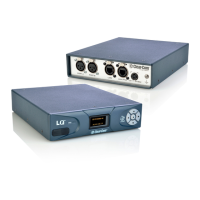16 Terminology/glossary
4-wire direct A 4-wire connection is characterised by two pairs of twisted
copper wire which transmit in opposite directions. A 4-wire
circuit gives a full-duplex interface which is often used to
connect to 3
rd
party devices. When used with the LQ Series, a
4-wire direct connection (as opposed to a channel) provides
point-to-point and panel connections over IP. The 4-wire
direct interface will pass panel data as well as audio. 2-wire
connections are inactive in the 4-wire direct tab of the
Assignments page in the CCM and cannot be used in this
context.
CCM Core Configuration Manager. This is the Web-based
configuration tool that each LQ device is supplied with. It can
be accessed by entering the IP address of your device (shown
on the device front panel) into the URL field of a Web
browser.
Channel In the context of the LQ product, a channel represents a
virtual party or conference line. A channel comprises audio
from audio interfaces on the devices (ports A & B and A-F)
that have been assigned to that channel. Within a channel, all
parties can hear and speak to each other.
Host device The LQ device whose Web-based configuration tool (CCM)
your browser is currently directed to.
Linking The act of joining multiple LQ devices together in one group.
Link-Group A set of devices linked together forming their own isolated
network.
Link-Master Role of a device within a Link-Group that provides central
reachability within the group as well as ownership of both
configuration and distribution of information.
Link-Member Role of a device within a Link-Group that shares client
privileges within the group.
Partyline In a partyline, all the participants on the line are involved in
the same conversation, they can hear and talk to all
members. In some contexts a partyline is known as a
conference line. Partylines can be 2-wire or 4-wire.

